Michigan hop update – July 8, 2014
Growers should be on the lookout for increasing potato leafhopper populations and Japanese beetles, as well as continue scouting for downy mildew.

Hop bines around Michigan have continued to thrive with warm temperatures and substantial rainfall supplementing irrigation. Growing degree day (GDD) accumulation is significantly different along the western portion of the state where the majority of hop acreage is located. So far this season, the Michigan State University Benton Harbor Enviro-weather station has accumulated 1,103 GDD50 with 2.4 inches of rain over the past week; the Clarksville Enviro-weather station has recorded 992 GDD50 with 2.04 inches of rain; the Bear Lake Enviro-weather station has accumulated 841 GDD50 with 0.62 inches of rain; and the Northwest Michigan Horticultural Research Center has accumulated 841 GDD50 with just under 0.62 inches of rain this past week. Despite some significant rainfall, growers will need to continue to water to meet the substantial water demands of hops.
Growers should carefully monitor their hops for potato leafhopper populations as significant populations are being observed. Potato leafhopper adults and nymphs move in all directions when disturbed, unlike some leafhoppers that have a distinct pattern of movement. Right now the adults and nymphs appear a fluorescent green color. Some very small nymphs are actually clear, but have the characteristic shape of the larger nymphs when viewed using a hand lens.
Potato leafhoppers can’t survive Michigan’s winter and survive in the Gulf States until adults migrate north in the spring on storm systems. Although hop plants are susceptible to potato leafhoppers, they can tolerate some level of feeding. There is no set economic threshold for potato leafhoppers in hops; however, some hopyards are seeing significant damage at this time.
Although hop plants are susceptible to potato leafhoppers, they can tolerate some level of feeding and growers should be conservative in the application of insecticides. Potato leafhopper feeding causes what growers have termed “hopper burn,” a necrosis of the leaf margin in a V-shaped pattern, giving leaves a yellowed or stunted appearance. Growers can agitate the bines and look for adults to take flight as a quick spot check but should confirm their presence and prevalence by flipping leaves over and looking for adults and wingless nymphs on the underside of leaves.
Growers needing to treat for potato leafhoppers can utilize products containing neonicitinoids (imidacloprid or thiamethoxam), pyrethroids (bifenthrin or beta-cyfluthrin),which may increase pest mite populations, organophosphates (malathion) or spinosyns (spinosad). Organic growers can utilize spinosad labeled as Entrust or pyrethrin labeled as Pyganic, both of which are OMRI-approved products for potato leafhopper management. For a complete list of registered products, refer to the Michigan State University Extension publication “Pesticides registered for use on hops in Michigan” and always read the label.
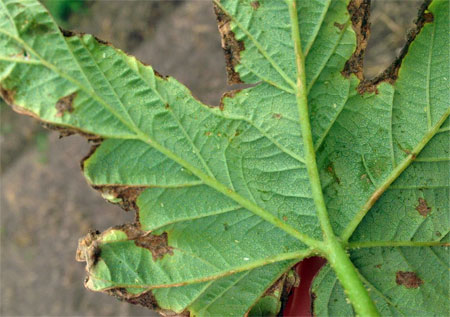
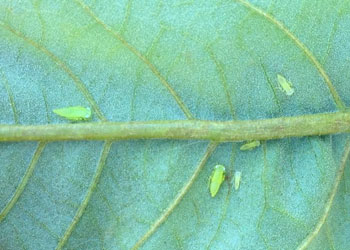
Left, Underside of hop leaf with leafhopper and burn symptoms present. Right, Multiple nymph stages of potato leafhoppers and the associated hopper burn symptoms around the leaf margin. Note that leafhoppers can be very small and clear at some leaf stages. Photo credits: Erin Lizotte, MSU Extension (left) and Mario Mandujano, MSU (right)
Most growers are seeing rose chafer adult activity subsiding just in time for Japanese beetles to arrive. Japanese beetle adults are considered a generalist pest that affects many crops found on or near grassy areas, particularly irrigated turf. Japanese beetle grubs feed on grass roots in early spring and again in the fall and can cause significant damage to turf. They prefer moist soil conditions and do not survive prolonged periods of drought.
Adult Japanese beetles emerge in early July and feed on hundreds of different plant species. Adult beetles feed on the top surface of leaves, skeletonizing the tissue. If populations are high, they can remove all of the green leaf material from between the veins on entire plants.
Japanese beetle adults are a substantial insect and measure 0.375 to 0.5 inches long. The thorax is green and wing covers are copper colored. There are five tufts of white hairs on both sides of the abdomen and a pair of tufts on the end of the abdomen that can help distinguish Japanese beetles from other look-alike species. The legs and head are black. Visual observation of adults or feeding damage is an effective scouting technique. Growers should scout along a transect through hopyards at least weekly until detection. Because of their aggregating behavior, they tend to be found in larger groups and are relatively easy to spot. Pheromone and floral baited traps are available and can help indicate the arrival of adults and estimate the potential pest pressure but are not considered effective for trapping out Japanese beetles. Growers considering the traps should remember that they may attract Japanese beetle adults from the surrounding area and contribute to damage.
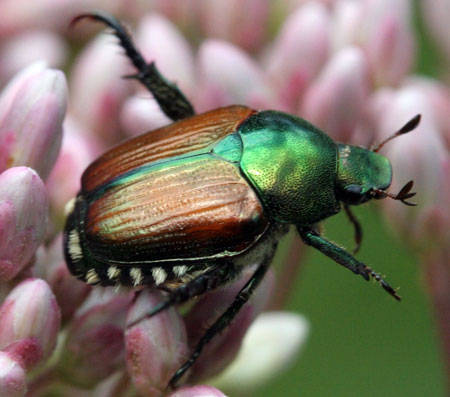
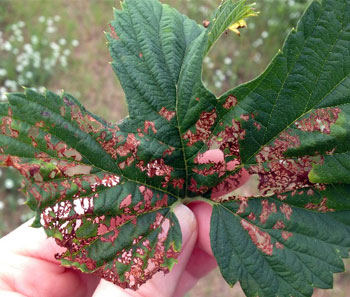
Left, Japanese beetle adult. Note the white tufts along the abdomen and emerald thorax. Right, Japanese beetle feeding damage on hop leaves leaving a lace-like appearance. Photo credits: David Cappaert, MSU, Bugwood.org (left) and Erin Lizotte, MSU Extension (right)
There are no established treatment thresholds or data on how much Japanese beetles damage hops can sustain. Well-established and vigorous bines will likely not require 100 percent protection, but younger bines with limited leaf area will need to be managed more aggressively. Also, if flower burrs are present and being fed on heavily, growers should consider management.
Managing Japanese beetles can be a frustrating endeavor as they often re-infest from surrounding areas, especially during peak adult emergence in July. This re-infestation is often misinterpreted as an insecticide failure, but efficacy trials have shown that a number of insecticides remain effective treatment options. Malathion is effective, but can take up to three days to take effect and provides 10-14 days of residual control. Pyrethroids (bifenthrin or beta-cyfluthrin) have good knockdown activity, and seven to 10 days of residual control, but can be problematic in hopyards where mites are a concern. Pyrethroid use has been shown to flare spider mite populations, killing predatory mites which help keep pest mite populations in check. Neonicitonoids (imidacloprid or thiamethoxam) have contact toxicity for two to five days, and then a longer residual period of plant protection during which they act as an anti-feedant.
OMRI-approved organic options include neem-based products (azadirachtin), which have a one- to two-day residual and good knockdown activity, as well as Surround (kaolin clay), which has had good results in blueberries and grapes and acts as a physical barrier and irritant. For a complete list of registered products, see “Pesticides registered for use on hops in Michigan” and always read the label.
With the substantial rainfall comes increased disease pressure for downy mildew. Many growers have been proactive in applying protectant early sprays as basal spikes emerged this spring and have continued to keep tissue covered with protectant fungicide applications every 10-21 days, depending on product and weather. Despite conservative and consistent spray programs, active downy mildew infections are present at this time. Downy mildew is caused by Pseudoperonospora humuli and can cause significant yield and quality losses depending on variety and when infection becomes established. In extreme cases, cones can become infected and the crown may die.
Typically, downy mildew appears early in the season on the emerging basal spikes. Spikes then appear stunted, brittle and distorted. Infected leaves have angular water soaked lesions that follow leaf venation. Eventually, the water-soaked lesions turn brown and necrotic with fuzzy and gray-black asexual spore masses developing on the underside of infected leaf lesions. As bines continue to expand, new tissue becomes infected and fails to climb the string. Growers can attempt to retrain new shoots, but often incur yield loss as a result.
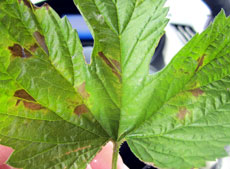

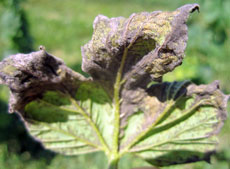
Left, Angular downy mildew lesions. Middle, Gray-brown fuzzy appearance of downy mildew fungus on the underside of a hop leaf. Right, Advanced downy mildew infection of the underside of the leaf. Photo credits: Erin Lizotte, MSU Extension
The causal agent of downy mildew overwinters in dormant buds or crowns, moving into buds during early spring and then into the tissue of the basal spikes as shoots expand. The pathogen produces copious spores on the underside of infected leaves. According to “A Field Guide for IPM in Hops,” infection is favored by mild to warm temperatures of 60 to 70 degrees Fahrenheit when free moisture is present for at least 1.5 hours, although leaf infection can occur at temperatures as low as 41 F when wetness persists for 24 hours or longer.
It takes a multipronged approach to manage for downy mildew. Growers should utilize a protectant fungicide management strategy to mitigate the risks of early and severe infections. Keep in mind that varieties vary widely in their susceptibility to downy mildew and select the more tolerant varieties when possible. Clean planting materials should also be selected when establishing new hopyards since this disease is readily spread via nursery stock. It is also recommended that growers pull all basal foliage during spring pruning. All pruning materials should be removed from the hopyard and covered up or burned to reduce inoculum.
Cultural practices alone are not enough to manage downy mildew. Well timed fungicide applications just after the first spikes emerge and before pruning have been shown to significantly improve infection levels season long. Subsequent fungicide applications should be made season long and in response to conducive environmental conditions (temperatures above 41 F and wetting events). Protectant fungicide strategies are particularly important during the year of planting to minimize crown infection and limit disease levels in the future. Fungicides containing copper, boscalid, pyraclostrobin, phosphorous acids, and a number of biopesticides have varying activity against downy mildew.
For organic growers, OMRI-approved copper formulations are the most effective. Washington State University has documented resistance in the downy mildew pathogen, Pseudoperonospora humuli, to fosetyl-Al, the active ingredient in Aliette. Based on these findings, growers are cautioned from relying on Aliette for downy mildew management. Aliette is not compatible with copper. For a complete list of fungicides labeled for the control of downy mildew on hops, see “Pesticides registered for use on hops in Michigan.”
If you already have downy mildew established in your hopyard, cultural practices will be very important in regaining ground as the season progresses. According to Oregon State University, diseased shoots on the string should be removed by hand and healthy shoots retrained in their place. Remove superfluous basal foliage and lower leaves to promote air movement in the canopy and to reduce the duration of wetting periods. If there is a cover crop, it should be mowed close to the ground. If yards have no cover crop, cultivation can help dry the soil and minimize humidity. Keep nitrogen applications moderate.
It is important that growers do not mistake downy mildew for powdery mildew as the effective pesticide classes are completely different. Powdery mildew has not been confirmed in Michigan and is caused by Podosphaera macularis, a completely different pathogen than what causes downy mildew.
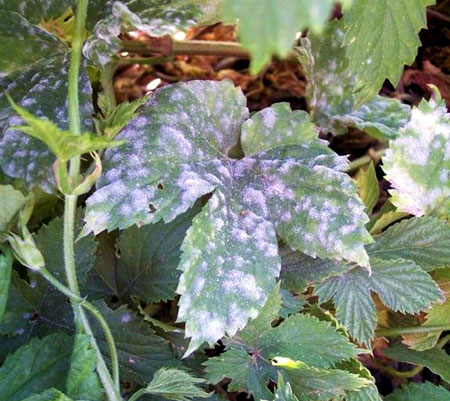
Round, white colonies of the powdery mildew fungus on the upper surface of hop leaves. Photo credit: David Gent, USDA-ARS, Bugwood.org



 Print
Print Email
Email


